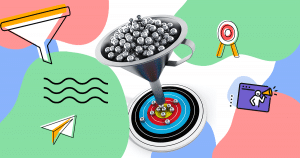A truly effective digital marketing campaign is more than just effective at raising awareness about a particular product or service. It’s capable of connecting with an audience on an entirely new level. When done correctly, amazing marketing leaves consumers feeling heard, understood, and curious enough about a brand to take those crucial next steps, such as making a purchase.
But these kinds of campaigns don’t happen by accident. They’re the results of thorough market research and a deep understanding of target audiences.
Although there are lots of ways to conduct market research, market research surveys are among the most effective and approachable. Here’s a closer look at everything you need to know to create and implement a market research survey from start to finish.
What Are Market Research Surveys?
A market research survey is a questionnaire designed to collect information directly from members of a target audience or demographic. The targets of a market research survey can be anyone from existing or potential customers to in-house employees, and the surveys can be conducted for any purpose.
Benefits of conducting market research surveys
Although there are many ways to conduct market research – including focus groups and interviews – there are unique benefits that surveys bring to the table.
To begin with, they allow you to collect standardized, one-to-one feedback at any scale you wish. Surveys can also help you:
- Get to know present and potential customers better
- Figure out what’s working about your brand or products and what’s not
- Find out what your target audience really thinks about you or your competition
- Learn what keeps your most loyal customers coming back again and again
- Ensure future marketing efforts are even more effective.
Market research surveys can help you leverage what people who aren’t happy with your brand think, as well. For example, you can implement exit surveys to help you assess why existing customers are canceling services or going elsewhere.
Different market research survey types
Market research surveys be either qualitative or quantitative.
- Qualitative market research surveys aim to go deeper into a target’s mindset with open-ended questions that start with words like “why” and “how”.
- Quantitative market research surveys involve quickfire questions designed to gather statistical data. Examples include questions that start with phrases like “how many,” “how much,” and similar.
Both types can be helpful ways to develop a better understanding of what makes your audience tick, test public perception of your brand, and lots more. You can also combine the two to gain more nuanced insights.
Planning Your Survey
Market research survey templates make terrific starting points for effective surveys. They help guide you through the basics of collecting demographic data and walking your target audience through targeted questions that will help you find out what you need to know.
You’ll also want to keep tips like the following in mind to ensure you get the absolute most out of your surveys.
Identify the problem
Before you get into the specifics of putting your marketing survey together, you need to get clear on why you’re conducting research in the first place.
What problem are you hoping to solve? Are you trying to make your marketing content more effective or work out the kinks in a new service you’re offering? Maybe you’re trying to figure out what keeps your best customers engaged and interested in your brand.
Understanding what you’re truly hoping to get out of a round of research gives you the foundation you need to ask the right questions and go after data that will really help your brand grow.
Identify the correct audience
Next, you need to figure out who the target audience of your survey is. Is this a general satisfaction survey you want to send to all your customers? Are you trying to get into the heads of customers from a specific demographic or who purchased a specific product?
While it’s definitely smart to go specific when it makes sense, your survey may not be as useful if you drill down so much in a certain niche that you don’t have enough respondents.
Choose the right survey type
Choosing the right type of survey is a critical part of making sure you wind up with thorough, useful results that will truly help you solve the problem you identified at the beginning of your process.
Start by figuring out whether a qualitative, quantitative, or mixed approach is the best fit. Then consider some of your niche options as far as survey types. Here are some examples.
- Persona surveys help you zero in on the pain points, behaviors, and needs of specific consumers. These can be used to help you improve products, build more effective buyer personas, and more.
- Brand awareness surveys are great ways to assess the public perception of your brand and gain new insight that can help you improve your efforts.
- Competitor research surveys can help you better assess how your target audience thinks you’re doing in comparison to your competition.
- Feature research surveys can help you assess how customers are reacting to recent changes you may have made to a product or service.
- Customer satisfaction surveys let you know how you’re doing at keeping your customers happy and meeting their needs, as well as helping you pinpoint areas where you could improve.
Ask effective questions
One of the most common mistakes marketers make when crafting market research surveys is asking the wrong types of questions. Good market survey questions are specific, direct, and on-topic.
So, avoid asking anything confusing or that doesn’t really apply to your objective. You’ll also want to avoid spoiling your results by introducing bias into the mix. Steer clear of elements that are persuasive or descriptive for this reason.
28 Questions to Ask on a Market Research Survey
The questions you ask are everything when it comes to the ultimate effectiveness of your market research surveys. Here are some key question types (with examples) to consider when putting your surveys together.
Demographic questions
Demographic questions help you discover key basics about your audience, the better to help you determine which demographics they belong to. Here are examples.
- How old are you?
- What is your ethnicity?
- What is your gender?
- Where do you live?
- What’s your highest level of education completed?
- What is your current employment status?
- What is your marital status?
- Do you have children or pets, and how many?
Product or service-related questions
Questions from this category help you learn more about your audience’s relationship with your products and services. Here are some examples to inspire you.
- Why did you decide to purchase this product or service?
- What did you like best about this product?
- How does this product help address your needs?
- How would you rate this product on ease of use, cost, etc.?
- How well did this product meet your expectations?
- Which of the following features did you find most useful?
- What features would make this product even better?
- How does this product stack up against similar products you’ve used?
Customer behavior and buying preference questions
This type of question helps you discover more about how your customers behave as consumers, what triggers them to complete a purchase, what keeps them coming back to a brand, and so forth. Here are examples.
- In your household, who makes the purchase decisions about this type of product?
- How often do you buy this type of product?
- Where do you shop most often for this type of product?
- How much do you usually spend on this type of product?
- What was your number one reason for buying this product?
- Where do you usually go to discover new products like this one?
- How would you rate your customer experience with us?
- Would you recommend us to a friend or family member?
Competitor analysis questions
These questions help you dig into how you’re doing as compared to your competitors – a great way to figure out what the competition might be doing that you’re not or vice versa. Check out these examples.
- What products have you used to solve this problem in the past?
- Do you shop with any of our competitors?
- How does our product compare to our competitors’ products?
- If you weren’t buying our product, what would you buy instead?
Conducting the Research Survey
Once you’ve decided why you’re conducting research and determined which market research survey questions you’ll be asking, it’s time to actually conduct your survey. Try these tips to make sure things go well.
Choose the right tools
There’s an entire wealth of market research tools and resources that can help take the guesswork out of many aspects of conducting effective market research.
Check out market research examples of successful surveys and compare them to your survey to see how it measures up. You can also supplement your own research by conducting additional independent research using resources like Statista or GrowthBar.
Ensure a high response rate
Beyond making sure you’re sending the right kind of survey to the correct target audience, here are other ways you can ensure as many respondents complete your survey as possible.
- Your customers are busy people and more likely to complete shorter surveys, so limit the length and make every question count.
- Offer incentives in exchange for completing the survey, like a discount on a future purchase or a chance to win a prize.
- Personalize the invitation to complete the survey by using the customer’s name and stressing why it’s important to you that they complete it.
- Give respondents who don’t complete the survey right away a second chance by following up.
Take steps to protect data
By completing your market research surveys, your customers are choosing to trust you with valuable information about themselves. Taking steps to ensure data validity and data protection is crucial for your customers and the integrity of your survey.
- Comply with all current data protection laws when conducting surveys.
- If you are sharing data with third parties, mention it explicitly.
- Consider anonymizing your data if dealing with sensitive information.
- Maintain careful control over which team members and personnel can access the data.
- Ensure validity by comparing your results with previous studies and other reliable sources.
- Check and confirm your results via methods like peer review, cross-validation, etc.
- When conducting product research, limit your survey to respondents with confirmed purchases.
Analyzing and Interpreting Survey Data
Once your survey is complete and you’ve collected all your data, it’s time to gather your findings, interpret them, and organize the info so that you can start using it to move toward your marketing goals. Here are a few tips to keep in mind as you do this.
Use tools to analyze your quantitative data
In cases where you’ve collected both qualitative and quantitative data, it can be helpful to go over the quantitative data first, in case it can help lend insight to the qualitative. Ensure the accuracy of your data analysis efforts by leveraging software and statistical tools.
Data analysis software can help you quickly and accurately identify patterns in your quantitative data that you might otherwise miss, leading to better, more useful insights.
Use qualitative data to gain insight
Qualitative data can be especially useful when it comes to getting into your customers’ heads. These are personalized, honest responses in their own words, and they’re absolute gold.
Keep your eyes peeled for unique insights or points of view that you might not have otherwise considered. Take ample notes. Then go over your findings collectively to determine what you’ve learned about your audience that you didn’t know before and how you can use it moving forward.
Organize your data for quick reference
Data is often at its most useful when presented in visual form. Present your findings via graphs, charts, tables, and easy-to-read reports. This ensures your data is easy to interpret and refer back to at a glance.
Conclusion
Effective market research surveys can help you gain valuable insight into your customers’ minds and hearts that it would be hard to gain any other way, so it’s important to make yours count any way you can.
Consider putting together a team of experienced content writers and creators to help streamline the processes of crafting irresistible invitation emails, assembling compelling data reports, creating dynamic new marketing content based on your findings, and more.
You’ll meet and connect with some of the best in the business when you sign up for your free 14-day WriterAccess trial today! Experience the difference the right expertise can make firsthand.

![[ROCK NA] [EBOOK SEO] Complete Guide](https://rockcontent.com/wp-content/uploads/2024/06/banner_Search-Engine-Optimization.png)






